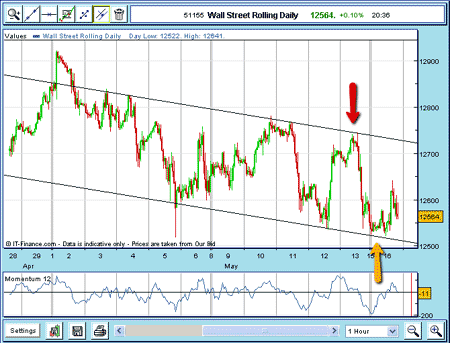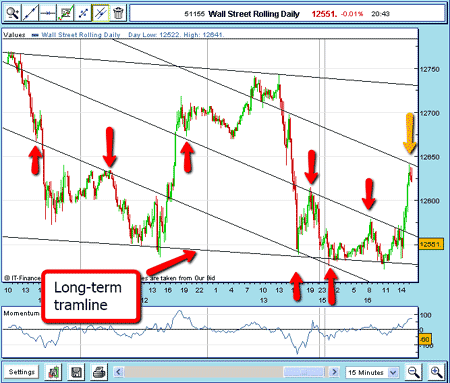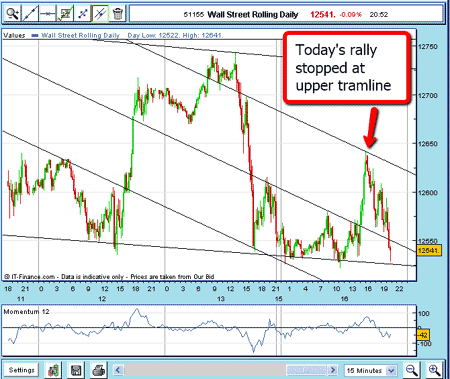The Dow Jones hits my targets
There are no guarantees in spread betting, but John C Burford believes that using a method that has proven itself over time - 'tramline trading' - can significantly increase your chances of making a profit. Here he illustrates this with a trade in the Dow Jones.
My previous post focused on the euro, where I showed a tramline target that was evaluated from two distinct tramline sets. Since writing that post, the market has rallied almost 200 pips in a few hours. My idea that the $1.4050 level provided solid support has been proved correct (in the short term).
But since markets have been moving in lock-step (I shall write a post on this very important point soon), stock markets followed the euro today (Monday 16 May) and have rallied. The connection between the euro and the Dow is almost pip-for-pip.
On 13 May, the Dow rallied right to my upper tramline (red arrow):
MoneyWeek
Subscribe to MoneyWeek today and get your first six magazine issues absolutely FREE

Sign up to Money Morning
Don't miss the latest investment and personal finances news, market analysis, plus money-saving tips with our free twice-daily newsletter
Don't miss the latest investment and personal finances news, market analysis, plus money-saving tips with our free twice-daily newsletter

(Click on the chart for a larger version)
But now, the market has fallen to my lower tramline (yellow arrow), and is currently trying to bounce up on oversold momentum.
What now?
When markets are trading near their tramlines, I find it useful to switch to a shorter time-frame. Here we have the 15-minute chart:

(Click on the chart for a larger version)
The patternpast the 16-hour mark on Friday is a typical mini-five wave pattern, which I see a lot. It often is the precursor of a minor wave up.
We have a plunge down at the 16-hour of 13 May, a rally up to my central tramline, then a move down early this morning, and then a rally back to my central tramline.
Then there is a move down, but not to a new low. That is a clue that the minor trend is now up. Very short-term traders could have jumped on this for a long trade.
And then came a rally above my central tramline. But to where? To my upper tramline, of course!
This upper tramline is drawn equidistant and parallel to the first pair. I can draw this tramline just after the upside break and well before the market has moved up to it.
And that is where the rally has stopped (so far). Here is the chart:

(Click on the chart for a larger version)
At the time of writing, the market has fallen to the area of this morning's low and is attempting to rally.
But now a short trade taken near the rally high is in profit and we can swing in our break-even rule to ensure no loss on this trade.
The importance of disciplined money management
Because shorting into rallies can be treacherous without a tried-and-tested technique, such as my tramline method, you can easily be flying blind.
By shorting rallies at the tramlines, you have the benefit of shorting into strength. That way, you can place your protective stops pretty close so as to limit losses if the trade goes against you and then invoke the break-even rule when appropriate.
While there are never any guarantees in trading, at least using these concepts, you have the benefit of using a method that has proven itself over time. Combine that with a solid money-management system, such as my 3% rule, and you have the basis of a very simple but formidable trading system.
By using such a system with discipline, any trader can expect to make profits over time. And the more trades you do, the better you will be at trading. Was it Gary Player who said: "You know, the more I practise, the luckier I get"?
I can tell you now that the famous traders that have made real fortunes in the markets almost all use a simple easy-to-understand methodology combined with a disciplined money-management rule.
But human nature is a weird and wonderful thing most of us want to complicate things and search for the next magic bullet that promises easy, huge profits because we have a 'secret' formula that we just plug in to the markets and hey presto!
In reality, there are no secrets to making profits, unless you call the application over time of simple, sound trading principles a 'secret'.
My methods are certainly not the only ones that work. There are many who profit using vastly different methods. In fact, one of my trading friends uses fundamental analysis alone and gets into big trends early. I just don't know how he does it!
All I am doing in these posts is to show you how I approach the markets and make it work for me. I sincerely hope it helps you in your trading.
NB: Don't miss my next trading insight. To receive all my spread betting blog posts by email, as soon as I've written them, just sign up here .
Get the latest financial news, insights and expert analysis from our award-winning MoneyWeek team, to help you understand what really matters when it comes to your finances.
John is is a British-born lapsed PhD physicist, who previously worked for Nasa on the Mars exploration team. He is a former commodity trading advisor with the US Commodities Futures Trading Commission, and worked in a boutique futures house in California in the 1980s.
He was a partner in one of the first futures newsletter advisory services, based in Washington DC, specialising in pork bellies and currencies. John is primarily a chart-reading trader, having cut his trading teeth in the days before PCs.
As well as his work in the financial world, he has launched, run and sold several 'real' businesses producing 'real' products.
-
 UK sets out crypto regulatory proposals
UK sets out crypto regulatory proposalsThe government has tabled legislation that sets out a regulatory framework for cryptocurrencies, while the regulator will consult on balancing innovation and consumer protections
-
 What does an interest rate cut mean for my pension?
What does an interest rate cut mean for my pension?Interest rates have been cut from 4% to 3.75%. For pension savers and retirees the effects of the drop will depend on the type of retirement pot they have, but could be significant.